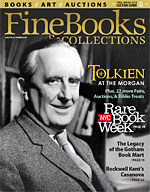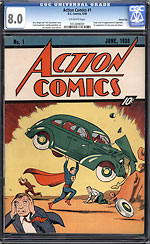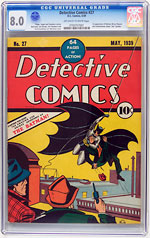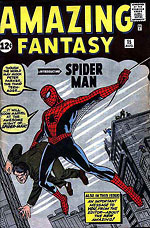Super Prices for Superheroes
Comic book collecting grows up By Jonathan Shipley Jonathan Shipley is a freelance writer living in Seattle with his young daughter. He’s been published in the LA Times, Boston Globe Diner Journal, and many other publications.
Kapow! Comic books are no longer just kiddy lit. Far from it. The numbers speak for themselves. In March 2010, Action Comics #1—the first appearance of Superman—sold for $1.5 million on an online auction site, making it the most expensive and valuable comic book of all time. Batman’s first solo title, Detective Comics #27, left Heritage Auctions for more than a million the month before, and just weeks ago, the Caped Crusader again brought in a hefty $492,937.
Six figures for Spider-Man’s first leap? Amazing Fantasy #15 realized $227,000, and that’s just one of many in recent years. Flash Comics #1 (1940, starring Flash and Hawkman) sold for $289,000; Marvel Comics #1, the first comic produced by the company that bore the Hulk, Iron Man, X-Men, and more, achieved $367,000; and All-American Comics #16, the first appearance of the Green Lantern, reached $430,000. Yes comic books have become a hot commodity of late, not just because of their potential investment value in the future, but because people who grew up with Captain Marvel and Archie, Daredevil and Ant Man, Wonder Woman and the Swamp Thing, are taking note of the artistic wonder and importance of comic books as cultural artifacts.
“Comics are such an incredibly unique form of art and literature,” exclaimed Arie Kaplan, Mad Magazine writer and author of Master of the Comic Book Universe Revealed! “When comics are done right,” he continued, “there really is nothing like them.” Michael Ring, owner of Portland, Oregon’s Bridge City Comics, said, “For a long time comics were considered ‘kid’s stuff.’ But now, especially after the explosion in the late 1980s of more mature fare, adults are realizing that comics have much to offer.”
Drawn in by the rich storytelling, whiz-bang art, and a connection to their childhood, adults with a little more discretionary income than those early days when they bought Fantastic Four comics at the corner drug store for a couple of nickels, have made comic book collecting big.
Barry Sandoval, director of operations of the comics division at Dallas’ Heritage Auctions, said Amazing Fantasy #15 comes through his auction house every few weeks. He once was involved in the sale of another Detective Comics #27 that sold for $657,250. “Once,” Sandoval recalled, “we got a call from a young guy who had some comics…One of the ones was a Suspense Comics #3, a really rare comic with a weird cover showing a hero saving a girl from Ku Klux Klan Nazis!” Despite its poor condition, it sold at auction from $3,300.
People shouldn’t get into collecting, however, with an eye towards blue-chip comics and high-end investments. The refrain is repeated time and time again by scholars, comic book owners, and comic book creators. “I don’t buy comics as investments,” Kaplan said, “I just buy them to read a good story.” “Read them,” insisted Maggie Thompson, senior editor for Comic Buyer’s Guide, “Enjoy them.” By buying (and reading) inexpensive comics for entertainment alone—discovering characters you enjoy, finding stories, writers, and artists you appreciate—your knowledge for comic books grows. That knowledge will help. Buying comic books as an investment, Thompson warned, “is not a good idea for the beginner. People who know nothing about the field will get burned.”
The field of collecting began in earnest in the 1960s. It was then that two publishers began to exert their dominance in the industry—DC Comics (publisher of Superman, Batman, etc.) and Marvel Comics (Spider-Man, X-Men, etc.). Before then, there were virtually no comic book stores as we know them today, and there were virtually no organizations or groups focusing on comics as collectible art. The Overstreet Comic Book Price Guide, the longest running publication devoted to assigning values to comic books, started publication in 1970.
It was also in the 1960s that underground cartoonists come to the fore and art, story, and style took the lead. “It was these comics, and the boom of the Silver Age, that caused readers and collectors to turn their eye towards comics as collectibles. The Silver Age was a time of artistic and commercial advancement in the industry. The revived Flash came on quickly, the first super superhero of those days. Martian Manhunter became “super.” The epitome of Silver Age comics is, arguably, the Stan Lee, Steve Ditko, Jack Kirby collaboration, the Fantastic Four. That team (and their heroes like Iron Man, Thor, and Daredevil) burst onto the scene with a combination of tension-filled narrative and sharp design.











